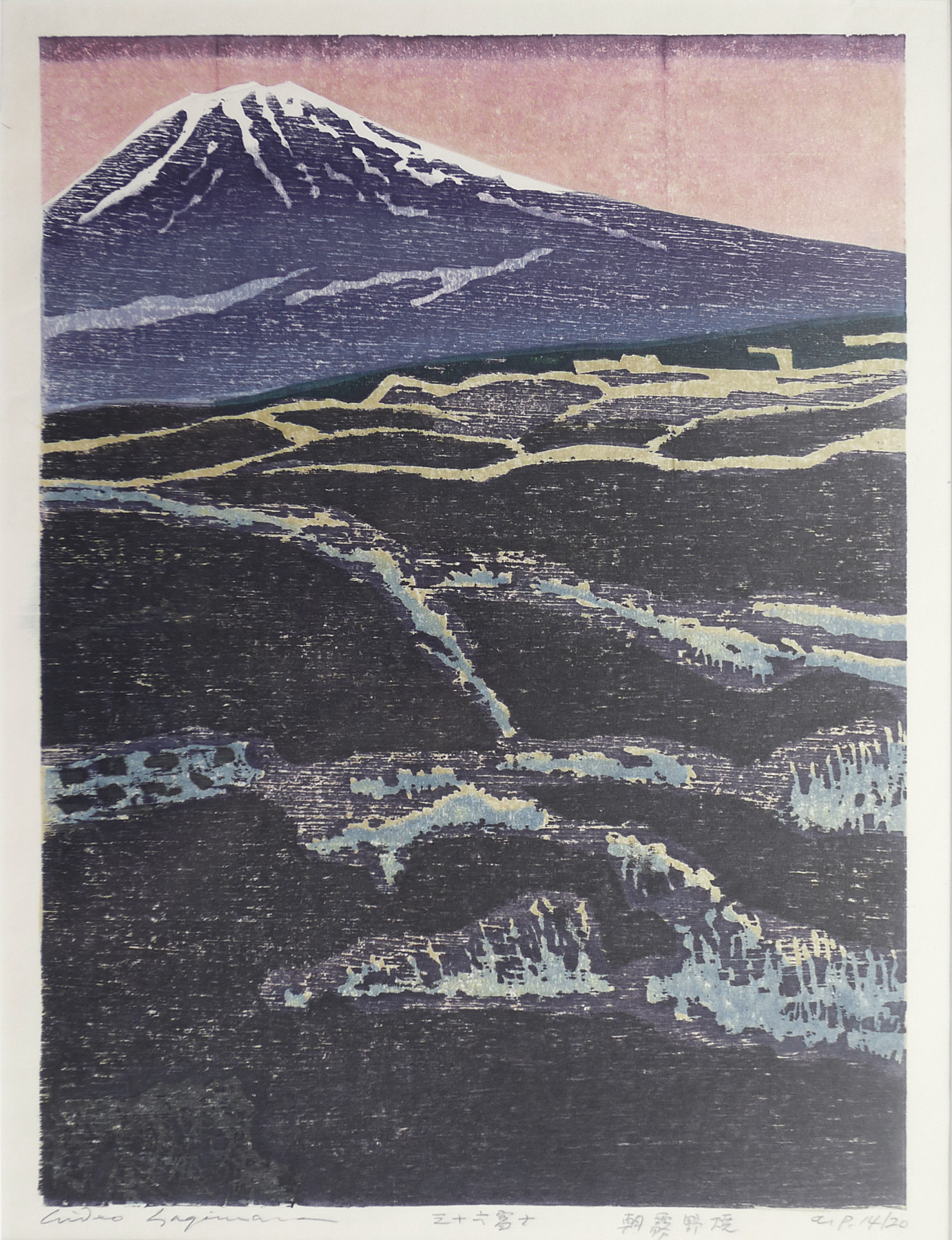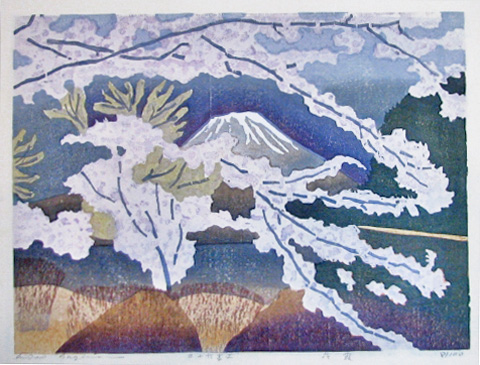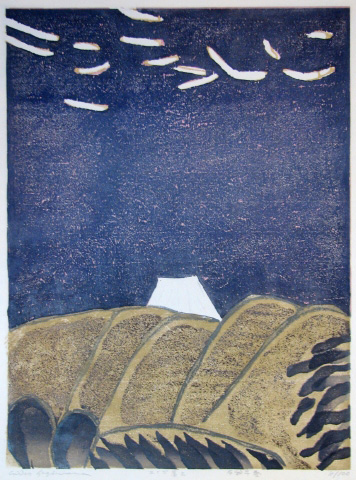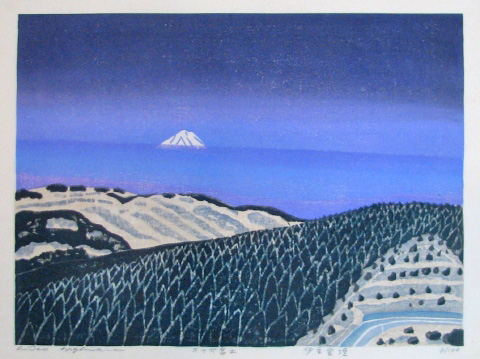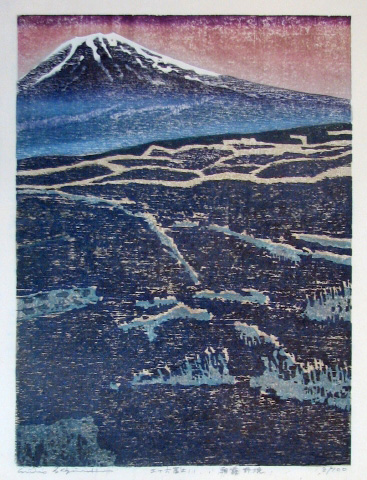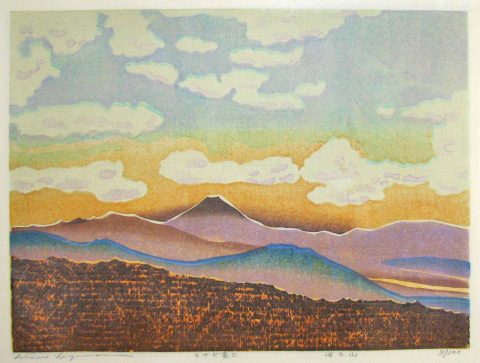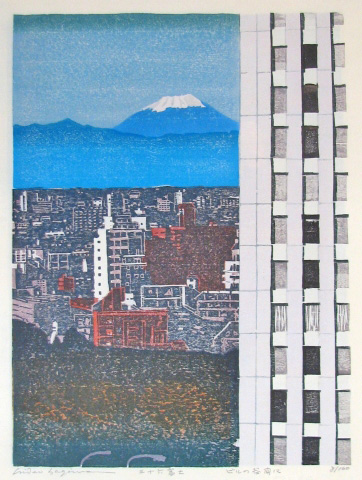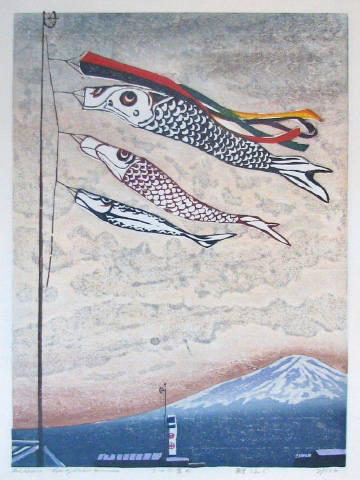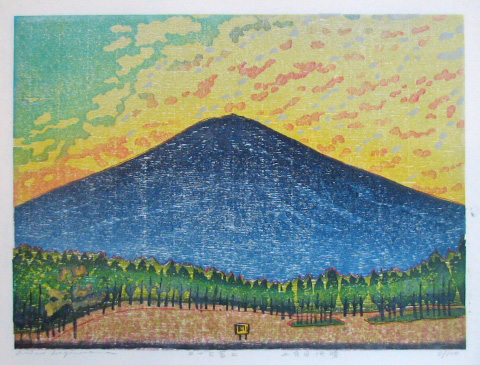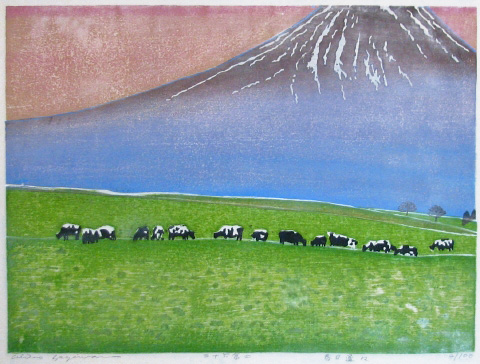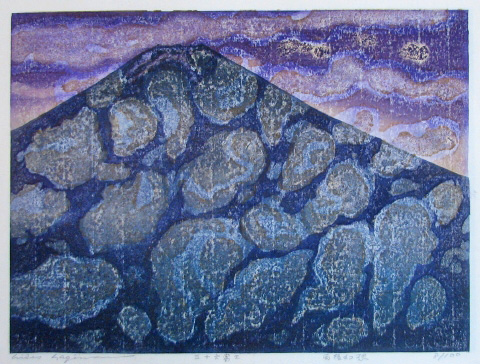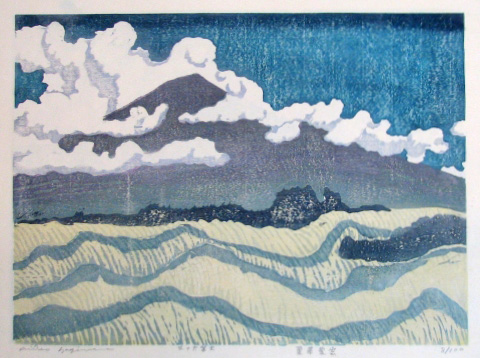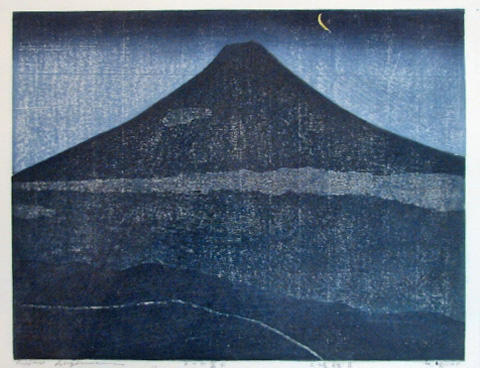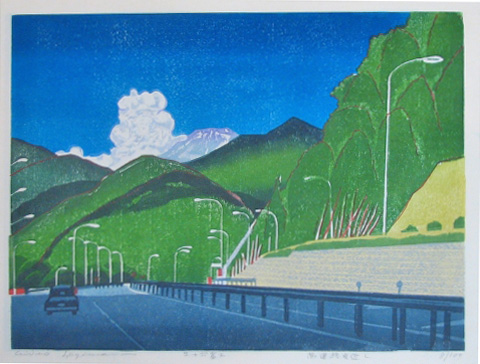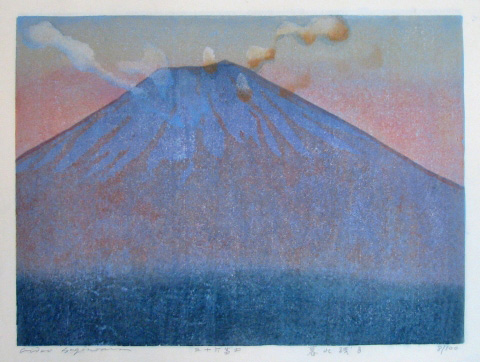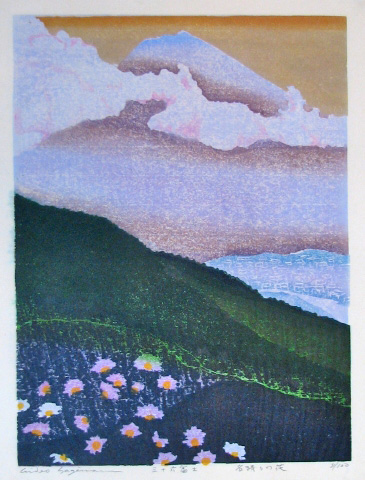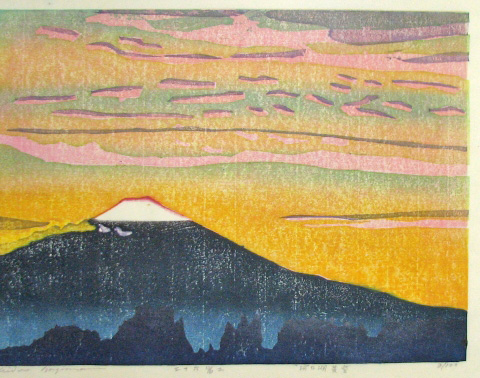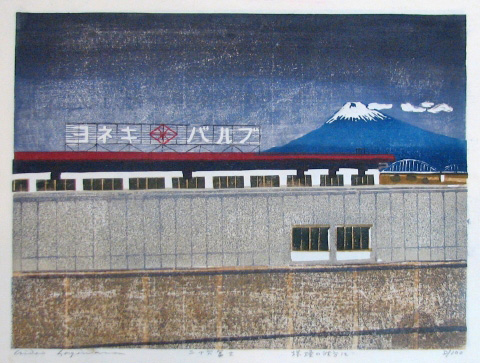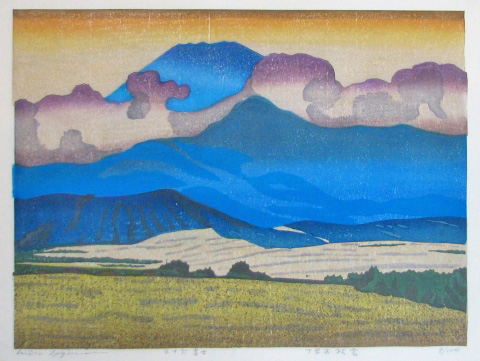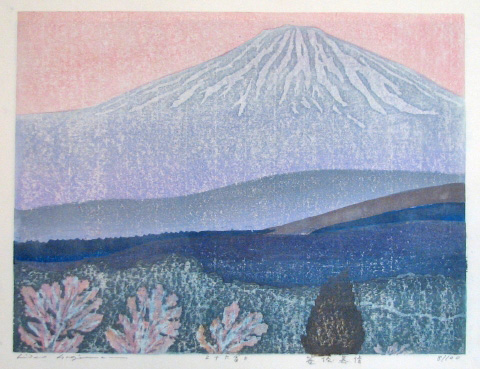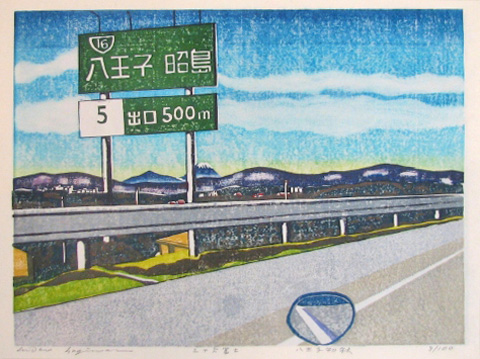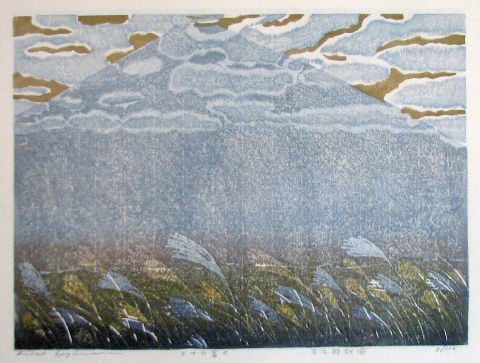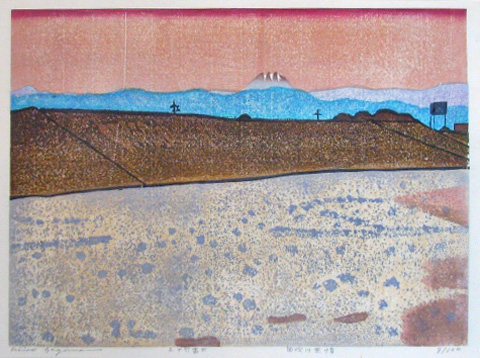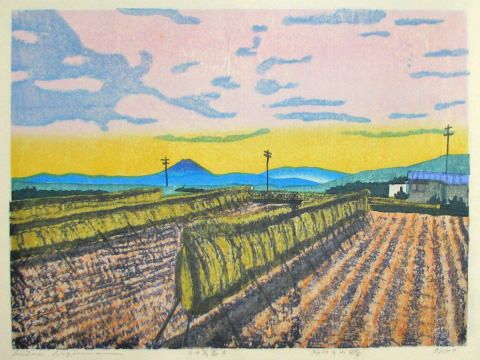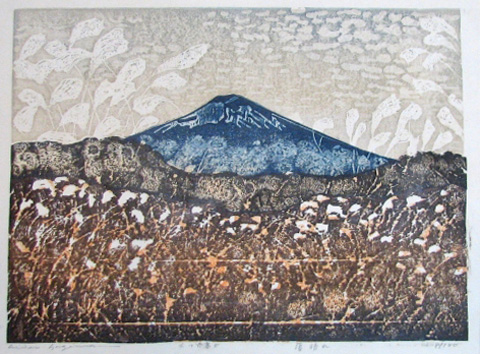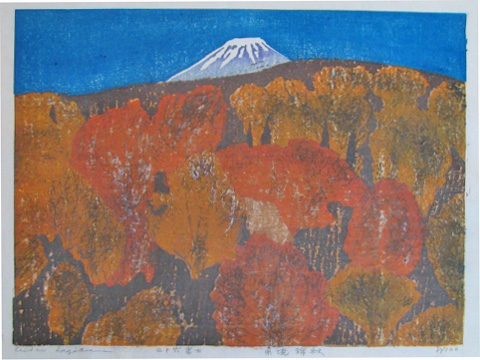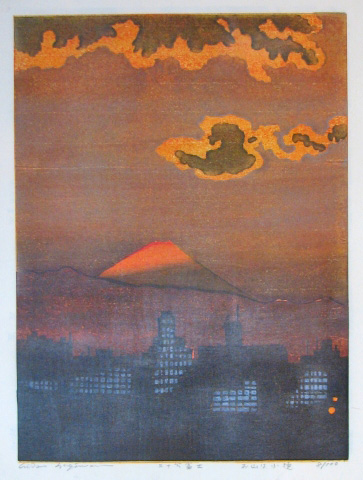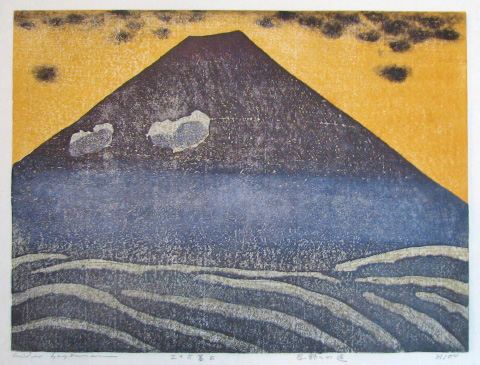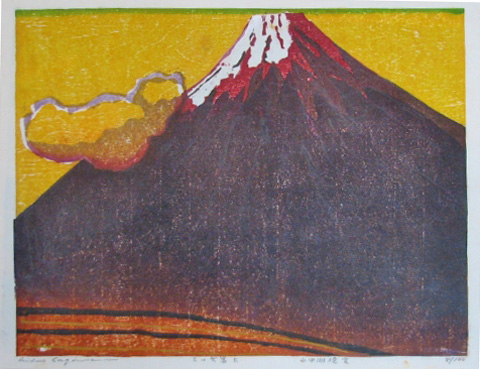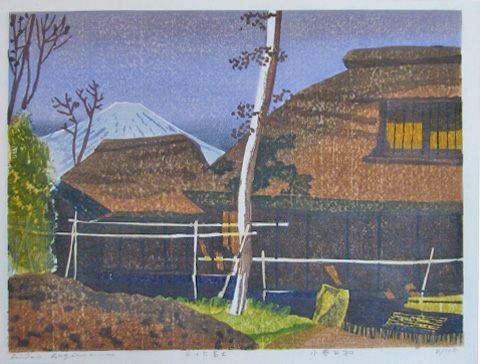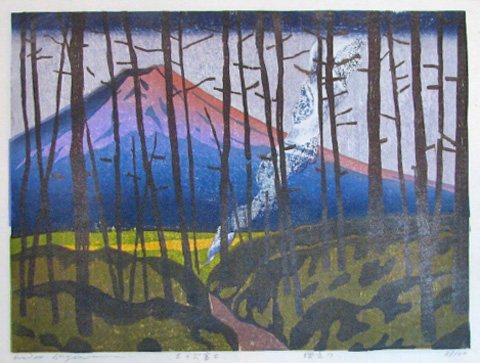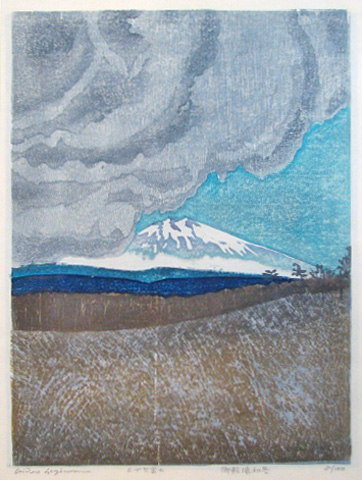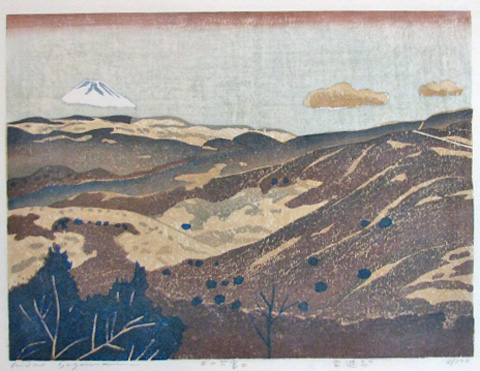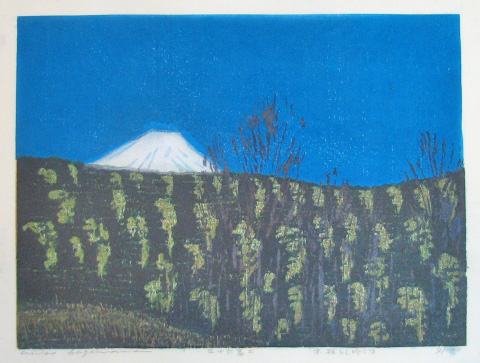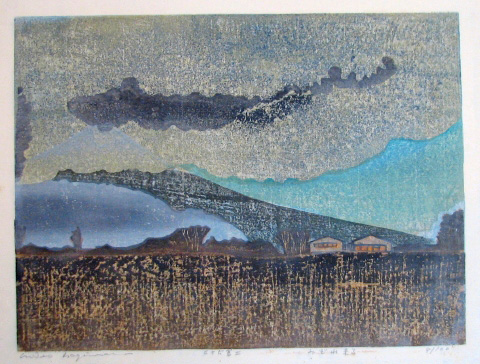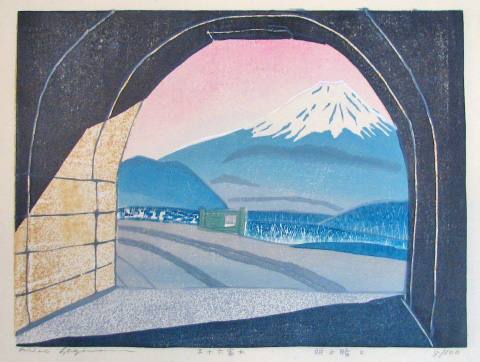About This Print
One of thirty-six prints created by Hagiwara as part of his series Thirty-six Fujis, created between 1981 and 1986. In this print Hagiwara captures the mountain as viewed from the small town of Ohara on a spring morning, through a morning mist, during the annual burning of grasslands (noyaki) on Fuji's northern foot. Hagiwara masterfully employs his unique color overlay technique to intensify his abstract coloration and a subtle dusting of ground mica highlights the colors.
"[T]he grasslands at the northern foot of Mount Fuji in Yamanashi Prefecture have been better preserved than any other in Japan. The commoners who own access rights to these grasslands control and maintain them by annual burning (“noyaki”), an activity that also reinforces their claims to the portion of the grasslands that were confiscated by the Japanese military in 1936 and are still used by the Japan Ground Self-Defense Forces. The north Fuji grasslands include the grasslands of Nashigahara (this area is also used as a training area by Japan’s Self-Defense Forces), Panorama-dai in Lake Yamanaka Village, and Takazasuyama in Oshino Village."1
萩原英雄 三十六富士:朝霧野焼 Hagiwara Hideo (1913-2007)
Morning Mist, Burning Fields,
from the series Thirty-Six Fujis1981/1986
Color woodblock print with embossing on paper
Lent by Irwin Lavenberg, L2018.62.5Hagiwara’s Thirty-Six Fujis series is the artist’s only excursion into landscape. It is his homage to the sacred mountain and to past ukiyo-e artists, such as Katsushika Hokusai (1760–1848) and Utagawa Hiroshige (1797–1858).Hagiwara captures a view of Fuji from the town of Ōhara on a spring morning, during the annual burning of grasslands (noyaki) on the northern foot of the mountain.
Sanjūroku Fuji 三十六富士 (Thirty-six Fujis)
Hagiwara created this series between 1981 and 1986, although it was many more years in the planning. It is the artist's homage (some say "challenge") to the famous ukiyo-e print artist Katsushika Hokusai and his Thirty-six Views of Mount Fuji (富嶽三十六景 Fugaku Sanjūrokkei) created in the early 1830s. But, whereas, Hokusai's views all include human activity, Hagiwara's thirty-six views focus on seasonal and atmospheric changes without directly showing the presence of man.
Special techniques used in the production of this series include kirazuri , the sprinkling of mica dust onto a light film of glue on the surface of the print while the ink is wet to achieve a subdued sparkle, the application of sawdust onto the woodblock to achieve an uneveness in the ink, and the use of varnish. To achieve Fuji's crown of snow, Hagiwara employed the technique of kimekomi (blind printing) a way of pressing out the paper to give a sense of volume.
In discussing why this series took so long to produce, Hagiwara states that while he was very familiar with the mountain, living in Kofu City, Yamashi Prefecture, "Mount Fuji looks like a beautiful mountain without faults, a beautiful woman without faults is very hard to paint."
Hagiwara's international reputation rests on the abstract woodblocks, bursting with saturated colour and rich in texture, that he has produced since 1958. The Thirty-Six Views of Fuji, his unique venture into landscape, nevertheless carries over may of these prized qualities... The artist announced in 1979 that he had already been out collecting ideas for the series in the vicinity of Fuji for 'ten years and more' and that he had commenced preparing the blocks 'the year before last'. Nevertheless he was finding it very difficult to complete the project: modern transport had expanded the number of places for viewing Fuji so much that this was perplexing him. These sentiments were echoed in the postscript to the publication that accompanied the completed set in 1986, in which Hagiwara wrote that the project had taken him twenty-five years: 'Just when I think I have grasped [Fuji], it slips through my hands. Let's pick up this "slippery Fuji" and keep on going.'2
1 website of the Overall Organizing Committee of IASC2013 https://c-linkage.com/for/iasc2013/en/registration_p2.html accessed 9-14-20
2 100 Views of Mount Fuji, Timothy Clark, Weatherhill, 2001, p. 68.
List of Prints and Thumbnails
Sora moeru 空燃える (Burning sky)Hana kasumi 花霞 (Cloudy weather in spring)
Ishiwa sōshun 石上早春 (Early spring at Ishiwa)
Izu un'en 伊豆雲煙 (Smoky clouds at Izu)
Yama mata yama 山又山 (Mountain after mountain)
Biru no tanima ni ビルの谷間に (Among skyscrapers)
Misaka zangetsu 三坂残月 (Pale morning moon at Misaka)
Kawaguchiko Tasogare 河口湖黄昏 (Twilight at Lake Kawaguchi)
Baien no kanata ni 煤煙の彼方に (Beyond the smoke)
Kagosaka bojō 篭坂慕情 (Longing at Kagosaka)
Kenkyō kinshū 県境錦秋 (Autumn colors at prefectural borders)
Oyama wa koyake お山は小焼 (Glowing mountain)
Gotenba shotō 御殿場初冬 (Early winter at Gotenba)
(Burning sky)
Hana kasumi 花霞
(Cloudy weather in spring)
Izu un'en 伊豆雲煙
(Smoky clouds at Izu)
Asagiri noyaki 朝霧野焼
(Morning mist, burning field)
Yama mata yama 山又山
(Mountain after mountain)
Biru no tanima ni ビルの谷間に
(Among skyscrapers)
Koi oyogu 鯉泳ぐ
(Swimming carp)
Nigōme kaisei 二合目快晴
(Fine weather at the second level)
Shunjitsu chichi 春日遅々
(Tranquility of a spring day)
Ugo gensō 雨後幻想
(Illusion after rain)
Natsukusa natsugumo 夏草夏雲
(Summer grass, summer clouds)
Misaka zangetsu 三坂残月
(Pale morning moon at Misaka)
Kōsoku shūten chikashi 高速終点近く
(Approaching the end of the highway)
Kure nokoru 暮れ残る
(Lingering twilight)
Nagori no hana 名残りの花
(Remaining flowers)
Kawaguchiko Tasogare 河口湖黄昏
(Twilight at Lake Kawaguchi)
Baien no kanata ni 煤煙の彼方に
(Beyond the smoke)
Jūriki akigumo 十里木秋雲
(Autumn clouds at Juriki)
(Longing at Kagosaka)
(Early autumn at Hachioji)
(Autumn wind at the foot of the mountain)
Fuefukigawa yojō 笛吹川余情
(Charm of Fuefuki River)
(Harvest)
Usubare 薄晴れ
(Hint of sunshine)
Kenkyō kinshū 県境錦秋
(Autumn colors at prefectural borders)
Oyama wa koyake お山は小焼
(Glowing mountain)
Shinobuno eno michi 忍野への途
(The way to Shinobuno)
Yamanakako gyōun 山中湖暁雲
(Dawn clouds at Lake Yamanaka)
(Indian summer)
Kemuri tatsu 煙立つ
(Smoke rising)
Gotenba shotō 御殿場初冬
(Early winter at Gotenba)
Kumo asobu 雲遊ぶ
(Cloud play)
Kogarashi kuru hi 木枯らし吹く日
(The day when the wintry wind comes)
Mizore kuru みぞれ来
(Approaching sleet)
Mei to an to 明と暗と
(Light and dark)
Print Details
| IHL Catalog | #1623 |
| Title or Description | 三十六富士 朝霧野焼 [as inscribed on print] Asagiri noyaki (Morning Mist, Burning Fields) |
| Series | Sanjūroku Fuji (Thirty-six Fujis) 三十六富士 |
| Artist | Hagiwara Hideo (1913 - 2007) |
| Signature | hideo hagaiwara - pencil signed by artist in English in lower left margin |
| Seal | |
| Publication Date | 1981-1986 |
| Edition | a. p. 14/20 |
| Publisher | self-published |
| Carver | self-carved |
| Printer | self-printed |
| Impression | excellent |
| Colors | excellent |
| Condition | excellent |
| Genre | sosaku hanga (creative print) |
| Miscellaneous |  |
| Format | dai-ōban |
| H x W Paper | 21 x 15 3/4 in. (53.3 x 40 cm) |
| H x W Image | 18 x 13 5/8 in. (45.7 x 34.6 cm) |
| Collections This Print | |
| Reference Literature | Gendai mokuhanga no kyoshō Hagiwara Hideo no sekai: Shōwa 61-nen 5-gatsu 24-nichi--6-gatsu 29-nichi, Yamanashi Kenritsu Bijutsukan, 1986, cat. no. 120. |


